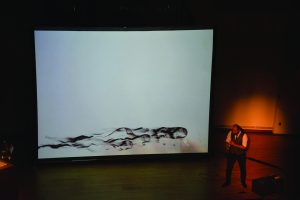Ghostly figures appear on the projector screen, their arms stretched up to the sky. A spotlight fades in on the center, highlighting the lone clarinetist who begins to play a slow, haunting melody. The image suddenly catches fire, and the entire painting is engulfed in flames.
This is the beginning of the first movement, “a sad morning, every morning,” from Syrian-born artists Kinan Azmeh and Kevork Mourad. Their joint work, “From Syria: Home Within,” a live, multimedia performance was presented at Brandeis last Saturday evening.
For almost sixty minutes, Azmeh and Mourad blended haunting visuals and powerful music. Mourad’s work was projected on a large screen, the audience seeing firsthand how he constructed his images using a unique water and pigment technique. The images appeared live as his spectral hand danced over the screen, the visuals perfectly complemented by Azmeh’s brooding clarinet compositions. It was a seamless and stirring live performance.


Mourad’s style reminded me of Picasso, specifically “Portrait of a Woman” (1910). He walks a fine line between representational art and abstraction—his style of depiction creating efficient images that are more than the sum of their parts. As we studied his painting on the screen, people, places and objects appeared—almost immediately, as if he had willed the abstractions to represent something. I was struck by the way he drew people: hooded figures, ghostlike, writhing. They were almost all faceless, and yet easy to empathize with.
Over the course of seven movements, Mourad painted 13 live paintings. I was amazed by his skill, how he was able to deftly create such moving imagery. This is the hallmark of a great artist: effective execution of a vision.
Besides the faceless figures, another recurring image for Mourad was of a city. Country and civilization have particularly poignant meanings for Mourad and Azmeh. They are both from Syria—Azmeh is from Damascus, Mourad from Aleppo—and their work directly engages with the violence and destruction that continues to rage in their home country.
I saw the depiction, multiple times, of a city falling apart, collapsing in on itself, or completely dissolving—Mourad would use his water-based pigment to wipe the buildings away. These powerful images, matched with Azmeh’s beautiful score, worked perfectly together.
The final movement, titled “and we are all optimistic,” first featured Mourad’s painting of a crowd of people trying to collectively pull a cart with an entire city, mosques, parapets and apartments on top of it. Then Mourad slowly pulled it off of the projector, the screen adding a motion blur that made it look like the people were somehow able to pull their heavy load.
Azmeh then walked over next to the screen, standing in profile against the white background.
As he began to play—this piece perhaps the least discordant, hopeful, even—a city started to grow out of the mouth of the clarinet. The buildings continued to multiply until they took up the entire screen. Then, Mourad drew a gate in front, and both stepped forward to either side and pulled the doors wide open. The screen zoomed forward through the doors, until everything was black. A title card appeared: “Dedicated to 500,000 Syrians… and still counting…”
The audience, a full house at the Slosberg Music Center, rose for a standing ovation. After a brief intermission, in which Syrian food from Boston-based Tarboosh was served, Mourad and Azmeh gave a brief Q&A.
“The Middle East is a place for storytelling,” Mourad said. “We wanted to show what’s going on in our country in a poetic way.”
“We’re not trying to tell the Syrian story,” Azmeh said, “We’re trying to document at different times how we have felt about the Syrian revolution…part of it is raising awareness that if the Syrian tragedy is not in the news it does not mean it’s not happening.”
But Mourad and Azmeh expressed that they felt differently about the future of their country. “I was optimistic until not too long ago. I do not have hope,” Mourad said. “Syria has changed forever.”
Azmeh said he was more hopeful, translating a quote from an Arabic poet: “‘We have been condemned by hope.’” He later said, “Having hope gets people into being pro-active…Syria is going through an evolutionary period.”
However, both artists said that their work was part of a desire to fill the cultural gap left by years of devastating war and mass migration—wanting to express the feelings of the dispossessed, of a ruined country. But, Mourad said, “This is a project inspired not by Syrian tragedy, but by human tragedy.”
Mourad and Azmeh’s work was both powerful and tragic. Through a seamless combination of mutual artistic skill, they were able to effectively tell a story in a beautiful way. Although the performance is over, some of Kevork Mourad’s other work can be viewed on campus at the Rose Art Museum. Titled “Immortal City,” I would recommend that any interested students visit the gallery. “Home Within” was a combination of beautiful art styles that profoundly resonated and provoked deep contemplation on the nature of human suffering, civilization and resilience.


